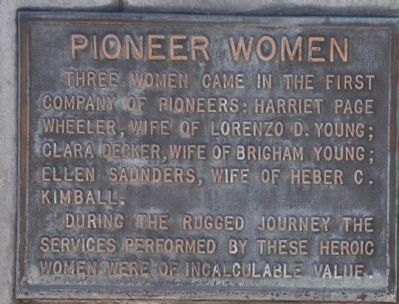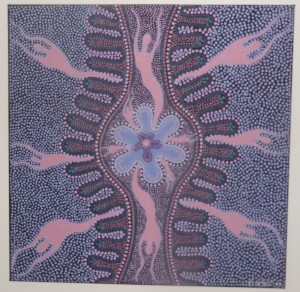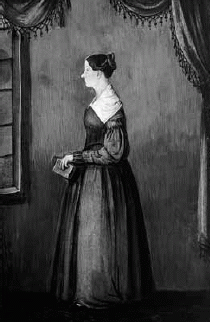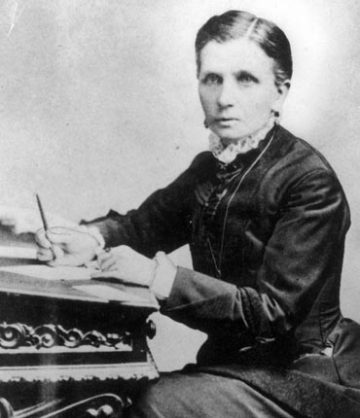 One of the most common comments (criticisms?) I hear when discussing programs or lessons on the Relief Society anniversary or Daughters in My Kingdom (DIMK), is the historical, but yet, American perspective. Indeed, in my ward, I have even heard members of the Relief Society presidency say that rather than teaching the history of DIMK, they aim to teach its concepts, avoiding a history that can sometimes feel like a distant, rote lecture to non-American, often first or second generation, converts. And yet, I perceive that this is one of the reasons that DIMK is written so simply; it can be easily read by average readers and it can be easily translated to a variety of languages because of its uncomplicated prose.
One of the most common comments (criticisms?) I hear when discussing programs or lessons on the Relief Society anniversary or Daughters in My Kingdom (DIMK), is the historical, but yet, American perspective. Indeed, in my ward, I have even heard members of the Relief Society presidency say that rather than teaching the history of DIMK, they aim to teach its concepts, avoiding a history that can sometimes feel like a distant, rote lecture to non-American, often first or second generation, converts. And yet, I perceive that this is one of the reasons that DIMK is written so simply; it can be easily read by average readers and it can be easily translated to a variety of languages because of its uncomplicated prose.
In this lesson plan, I hope to address significant concepts applicable to all Mormon women as well as address the Relief Society history as presented within the framework of this chapter.
The online chapter heading (absent in the hard copy) includes a powerful quote by Emmaline B. Wells, 5th General President of the Relief Society:
The sisters never lost sight of the institution, nor the promises made to them by President Joseph Smith. … They were always ready with willing hands and tender sympathies to perform deeds of love and charity, and many were in need of such kindly acts for those were the days of toil, and of suffering, of scarcity and of hardship.
This quote is used in reference to the time period covered in the chapter. It begins with the martyrdom of Joseph Smith, and states that “Leading up to this difficult time, the formal organization of the Female Relief Society was discontinued.” (DIMK, 29)
Shortly before the prophet’s death, Emma Smith, wife of the prophet and Relief Society General President, had begun to actively petition against polygamy. The last recorded meeting of the Society was in March 1844, three months before the death of the prophet. Emma Smith’s conduct in proselytising against polygamy was seen as partnership with some other prominent church members who openly dissented against Joseph Smith. In this, it is no wonder that at Joseph Smith’s death, the leader of the Quorum of the Twelve Apostles, Brigham Young, focused on church unity. According to Young, a part of this unity was found in the dissolution of the Relief Society, as he distrusted the group because of its anti-polygamy agenda. (Women of Covenant, 61-63.)
Although there was no formal Relief Society organization from 1844 until 1866, Emmaline Wells wrote “Sister Eliza R Snow brought with her the records from Nauvoo which proves that this association was never discontinued since its first organization.” (Woman’s Exponent, October 1911, 24.) For Wells, it seems that because Eliza had cared for the physical records, the revelation of the Relief Society was still intact, though a general leadership has ceased. Indeed, in the years between formal Relief Societies, there are dozens of records of individual groups of Mormon women who gathered to be of service in gathering materials, funds and sewing for benevolent purposes.
Flash forward to today. This is an international church. Most of us will meet in Relief Societies with a dozen or more women, and will have the choice of attending or participating in different projects in relationship to our local Relief Society. But there are others of us who might be the only member of the Relief Society in the town where we live. There will be other times where we are the only church member in our school, work or social group. I know of a few women who became the instant Relief Society presidents in their branch, if only because, as the only church members in their area, their family was made into a branch, and the husband (if “active”) as branch president.
and will have the choice of attending or participating in different projects in relationship to our local Relief Society. But there are others of us who might be the only member of the Relief Society in the town where we live. There will be other times where we are the only church member in our school, work or social group. I know of a few women who became the instant Relief Society presidents in their branch, if only because, as the only church members in their area, their family was made into a branch, and the husband (if “active”) as branch president.
(Did you know? Because the Relief Society created the Primary and MIA/youth programs, in areas where there is only one “active” church-member family, the woman is set apart as president of Relief Society, not as president of the Primary or otherwise because of the associated developmental church history.)
How can and do we, as representatives of the Relief Society, maintain the purpose of Charity Never Faileth in any setting, regardless if it is a traditional Relief Society gathering?
Joseph Smith was martyred in 1844, but the exodus west was not until 1846. This in-between period was anxious for the saints as they sought temple endowment before being forced to abandon the temple. I think this is an interesting thought: at this time, the Nauvoo temple was the only temple in operation, so it was the only place for families to be sealed. Having witnessed the martyrdom of Joseph Smith, and experienced the massacre at Haun’s Mill in 1838, death was a ready reality to the Saints. Having no idea of when another temple could be built, or what might happen next, those anxious to express their dedication to God and the church by becoming endowed, as well as those anxious to be sealed to their families would have been nearly frantic to make use of the temple, as is described in the text.
Although the temple is not a comfortable experience for everyone, I think it is appropriate to consider the symbolism of the temple though the lens of these early church members. For consideration:
- Prior to 1958 when the church opened its worldwide building program, many members outside of the United States simply had no hope of ever being able to afford the travel costs to go to the temple. Though the temple building programs of the last decade have all but solved the problem of temple availability, there are still some, through physical distance or lifestyle choices may not attend the temple. In consideration of this, how can the ideas associated with the temple bring us peace? How does the idea of being covenanted with God (even if not through the temple) help us in trials?
- Even when there are strained family relationships (as surly the early saints had as well) how can the idea of being sealed in a covenant with God, or sealed within a family unit bring peace?
- How do our own insights and interpretations develop when we study in and out of the temple? Some of my temple-inspired thoughts are here and here and here.
From DIMK:
Before leaving Nauvoo, a group of Latter-day Saints wrote the following message on the wall of the assembly hall in their abandoned temple: “The Lord has beheld our sacrifice: come after us.”
When I was in high school, I was accused of stealing a coat. I didn’t steal the coat. But a group of girls said I did, and began to threaten me. I was in a dark place, and was very frightened for my physical safety. I felt very alone. I was so scared that I even told my mother- and I was not close to her at all. She said, “You didn’t steal it. They might take your coat. You might just have to sacrifice that. But you will be protected [by God] because you did not steal their coat.”
She was almost right. I didn’t sacrifice my coat. A few days after being accused, the coat re-appeared and I was told that I was no longer in line for a beating. I wish I could say that I had more courage at that time than I did. But I was afraid and didn’t have faith in being protected of my own. It was my mother who had faith that I would be protected, and I felt better in expressing to her my scary situation. I think this is similar to the faith of the saints. They were probably scared, afraid, not know what was coming next and unsure of what would happen. But they knew that they had made covenants with Heavenly Parents, who would ultimately do all they could to protect them. Even when we might not have faith in themselves, they had faith in their Heavenly Parents who could offer peace in facing yet another trial. In summary, I do not think that “come after us,” was to taunt the mobs, I think it was a declaration of testimony.
Consider this beautiful, original Australia Aboriginal artwork that I have hanging in my bedroom. It is of Aboriginal Spirit Women, and the female artist told me that she was inspired to create this in a series because of the spiritual women in her life, women of The Dreaming. One must gain permission to share spiritual direction associated with The Dreaming, so I will not share what the artist taught me as a matter of respect for her religion. But, in a summary, this spirituality is seen as a oneness of creation, a lifeforce beyond now and into The Dreaming (spiritual realm). Anything that is living has a life force within to create good. I think of women of the church like this- we all have the ability, the inner spiritual direction within which we can do good, and greate good in the lives of those surrounding us. It is a declaration that in any situation, we have an inner ability to create goodness.
I have hanging in my bedroom. It is of Aboriginal Spirit Women, and the female artist told me that she was inspired to create this in a series because of the spiritual women in her life, women of The Dreaming. One must gain permission to share spiritual direction associated with The Dreaming, so I will not share what the artist taught me as a matter of respect for her religion. But, in a summary, this spirituality is seen as a oneness of creation, a lifeforce beyond now and into The Dreaming (spiritual realm). Anything that is living has a life force within to create good. I think of women of the church like this- we all have the ability, the inner spiritual direction within which we can do good, and greate good in the lives of those surrounding us. It is a declaration that in any situation, we have an inner ability to create goodness.
Have you been in a situation where you feel persecuted, yet empowered because you, or those in your group, had the spirit with you?
From DIMK:
In a revelation given to Brigham Young “concerning the Camp of Israel in their journeyings to the West,” the Lord commanded the pioneers to “let each company bear an equal proportion, according to the dividend of their property, in taking the poor, the widows, the fatherless, and the families of those who have gone into the army.”
In the tradition of Masculinity studies, voluntary organizations  (think ambulances, paramedics, firemen, etc.) are organized with military titles, just as the DIMK reminds us that the pioneer companies were organized with a “Captain” at the head. The purpose behind this is to create a leadership structure so in case of an emergency, someone is in charge and tasked to organize the others. This is not a perfect policy, as you will find in The Women of Mormondom when Mary Smith challenged her captain when he declared her unfit to travel. Along the way, he commanded others in the company to not aid her, and made her trip as uncomfortable as possible. But she still prevailed, beating the captain into the Salt Lake valley 20 hours in advance of the captain. The text to this can be found here. (Women of Mormondom, 344-349)
(think ambulances, paramedics, firemen, etc.) are organized with military titles, just as the DIMK reminds us that the pioneer companies were organized with a “Captain” at the head. The purpose behind this is to create a leadership structure so in case of an emergency, someone is in charge and tasked to organize the others. This is not a perfect policy, as you will find in The Women of Mormondom when Mary Smith challenged her captain when he declared her unfit to travel. Along the way, he commanded others in the company to not aid her, and made her trip as uncomfortable as possible. But she still prevailed, beating the captain into the Salt Lake valley 20 hours in advance of the captain. The text to this can be found here. (Women of Mormondom, 344-349)
The church is imperfect. Sometimes people don’t do their callings, sometimes people fall through or antiquated policies make simple tasks difficult or impossible. How can we remain dedicated to Christ when we face opposition within the church?
The next section of the lesson discusses the loss of infant children as they made their way and settled in Utah. I think the underlying theme of this section is the sense of sisterhood.
Eliza Partridge Lyman is quoted regarding her own loss, then her compassion at spending time with a friend who had also lost a child:
“I still have friends who are dear to me. If I had not I should wish to bid this world farewell, for it is full of disappointments and sorrow. But I believe there is a power that watches over us and does all things right.”
As Eliza said, she was sustained by the friendship of caring sisters. Later she provided that same friendship and compassion, helping other women who were dealing with similar grief. On June 1, 1847, she wrote:
“Sister Elvira Holmes’ babe died. Received an invitation … to come and spend the day with her which I accepted. Visited with her the grave of her child.”
It is clear that friendship was a powerful force in the emotional survival of these women. Do we feel the same about our friends? What are some ways we can extend friendship, empathy and compassion to those who are suffering from:
loss of a job
loss of a spouse (divorce or otherwise)
loss of a child (including miscarriage or infertility)
From DIMK:
“The love of God flowed from heart to heart,” wrote Helen Mar Whitney [in reference to her trek west], “till the wicked one seemed powerless in his efforts to get between us and the Lord, and his cruel darts, in some instances, were shorn of their sting.”
Note that the included phrase “in some instances.” This does not mean all of our trials will be painless, and what may be easy trial for one may not be easy for another. Being sensitive to others’ trials is imperative to successful, Christ-like sisterhood.
Emmeline B. Wells: ‘[The Mormon women] were always ready with willing hands and tender sympathies to perform deeds of love and charity, and many were in need of such kindly acts for those were the days of toil, and of suffering, of scarcity and of hardship.”
The last part of this chapter discusses various ways in which the pioneer women, still not formally associated with a restored Relief Society, maintained the spirit of Relief Society by being of service to each other as they settled and organized homes in the Salt Lake Valley. Amid their own settlement they also assisted neighbouring Native Americans, and donated and sewed for other incoming pioneer companies who were in desperate circumstances. In this, the chapter is completed with resolving that with or without a formal organization, Relief Society sisters openly seek opportunities in which they can serve others in and out of their immediate social circles.
Consider the women I addressed at the start of this lesson- women who are they only members of the Relief Society in their regions, towns, school, work, social group or otherwise. Outside of a formal “service” activity, how can they, and each of us, be of service to others?
Personally, I have three examples:
1. This guest post by Kristel, wherein she chose to go and serve in Kenya, just because.
2. Another friend learned of sewing machines that were being donated to impoverished areas of Fiji. Of her own volition, she gathered money, sewing supplies and a friend. The two women travelled to Fiji to teach basic quilting and donate materials. They had three goals for the project: 1. Give the women lessons and supplies wherein they develop sewing skills. 2. Teach the women to patchwork quilt so they could create products from the donated materials to seel for food, school fees for children and purchase more supplies to create an income. 3. Teach the women basic sewing so they could make and patch clothes for their children.
3. One Christmas, when my husband and I really were the only two church members in a town where we lived, we decided to do a Mormon Service project for the twelve days of Christmas. Because 50% of this effort was completed by me, the only member of the Relief Society in town, I have decided it was also a Relief Society activity. We went around every day for the twelve days leading to Christmas and cleaned up community areas that were understaffed because of Christmas holiday leave. Did anyone besides us know until I wrote it in this post? No. Did I feel good about it? Yes. Was it fun for my marriage? Yes. Did we feel the spirit as we did it? BIG YES.
How can you take upon yourself the armour of Christ and serve, whether in or outside the Relief Society?
Challenge the women to set a goal to seek a way they can serve, according to the demands of their family and budget, even if it is for a one-off tiny thing. (a hint I stole from another friend: whenever she knows of someone having a baby, in her ward or not, she cooks them a meal.)
Overall, I think “Cleave to the Covenants” is not necessarily focused on covenants made in the temple, though a significant part of this lesson is focused on the temple. I think the covenants this can be interpreted to represent are found within the framework of the Relief Society, as in “Charity Never Faileth.” No matter our circumstance, we can be of service to others, express sisterhood and remain diligent in our desires and actions to offer compassionate, “tender sympathies” as originally instituted in the first Relief Society meetings.
Do you have personal covenants regarding service and compassion that you strive to maintain in and outside of Relief Society?
How can you express Relief Society sisterhood in non-traditional ways?






7 Responses
Brilliant as always, Spunky. You have a gift for making this stuff come alive.
” According to Young, a part of this unity was found in the dissolution of the Relief Society, as he distrusted the group because of its anti-polygamy agenda. ”
I find it increasingly difficult to respect (or even tolerate) Brigham Young.
I have wondered how a non-US based ward or Relief Society would approach these lessons. Thank you for an enlightening approach.
The sad thing is, that is my experience, most wards in Australia have an American ex-pat who goes and does some pioneer-y American thing and only focuses on the American side of things. The history of Mormon women is wonderful to be sure, but for those new to the church, or not willing or don’t know how to move a lesson into a more personalised application, the history only becomes a rote lecture for fear of losing the spirit by not “sticking to the book.” I really hope women across the world see, understand and add a personal approach to DIMK and all RS lessons so that a balanced history of international Mormon women can be recorded and celebrated.
[…] After Brigham Young’s endorsement, similar societies were developed in other areas of the territory, but most of these efforts were short-lived. Reference F (More information about this time period is available here.) […]
Thanks for Your post.
Choosing an immigration or bankruptcy law firm is an important decision, and we understand that clients have many options to choose from. At Exodus Immigration, we stand apart from the rest by offering personalized attention, expert legal guidance, and a track record of success. Our team is committed to providing the highest level of service and support to every client we serve.